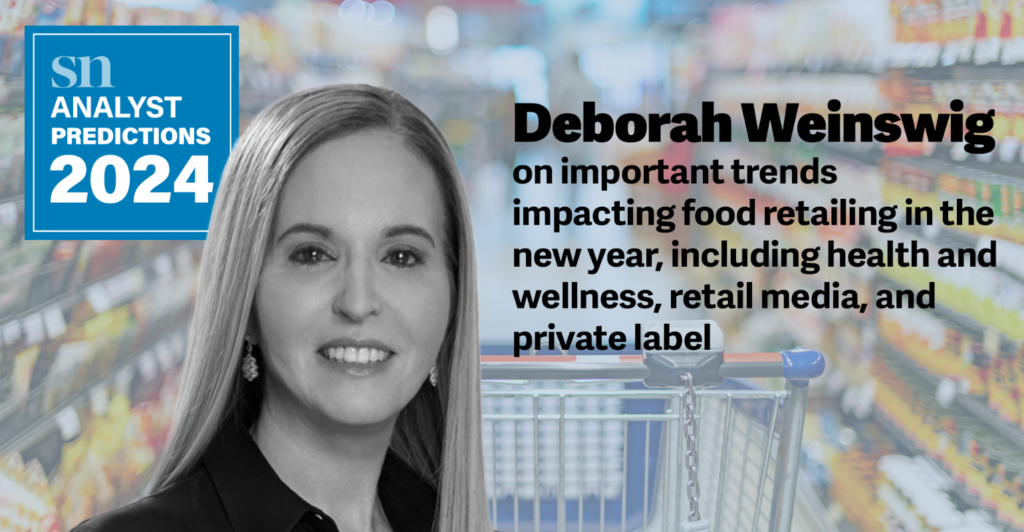Supermarket News recently sat down with several analysts to look at forward-facing food and retail trends. In a video interview with Deborah Weinswig, founder and CEO, Coresight Research, Weinswig talked about health and wellness, retail media, and private label. Not to mention Ozempic.
Take a watch or read a transcribed excerpt below.
SN: What do you see as some of the key trends impacting food retailing in 2024?
DEBORAH WEINSWIG: Let’s start with the “Ozempic economy.” We have real changes happening there. We have changes in terms of the quality and quantity of what people are eating, and where they’re potentially redeploying money that they would’ve spent on grocery.
Secondly, we’re seeing more health and wellness move into the grocery, and this idea around “food prescriptions” and “food as medicine.” I had gone to Mayo Clinic in Rochester, and I was diagnosed with Celiac. They told me I can’t eat barley, wheat, and rye, and their “prescription” for me was to go to Whole Foods, and go to the concierge desk. They walked me around the entire store and showed me what I could and couldn’t eat. And we’ve talked to many grocers who said having either a nutritionist or some consultants on staff, or having that [information] available through an app, is a bigger focus for them in the year ahead.
Then, if we think about retail media networks, I believe we’ll continue to see consolidation and the opportunity for retailers to drive revenue in a new way. And it is not just retail media networks, it’s monetizing their [intellectual property] and monetizing their data. That allows the grocery segment to invest more in technology. It goes back to better data, better engagement for the consumer, [and an] easier customer journey on an app or online. There’s a million things that does, but ultimately, I look at it from the grocer’s perspective that they now have this other source of revenue.
Another trend is around private labels. During the pandemic, the closest full grocer was Aldi, and I got very used to buying those brands. It is the retailer’s own brand, and I feel like we hear bits and bites of them talking about it that way. And of course we’re seeing them continue to increase in penetration. I just think there’s a whole other opportunity to drive growth for private label and ultimately the top line and bottom line.
Buy online, pick up in car
I was with somebody last week who lives outside of Lexington, Ky., and he said that at his Walmart he’s counted 35 spots for buy online and [have it brought to your car]. And, he said they have to wait in line to get one of the spots. As a consumer, you’re in a bit more of control [compared with home delivery] especially with groceries and things that are perishable.
The challenge is there is cost associated with that, which, once again, I think you can offset through retail media networks, data monetization, IP monetization.
Once you have that one-to-one relationship with the consumer, there’s this idea that we can engage people with ‘car commerce,’ I call it. We can start to engage people in a different way, and we get permission to sell them more and to develop a relationship.
With Instacart, I can now try to book the same person. With Target and Shipt, that’s their big thing is to be able to book the same Shipt-er. And when you start to develop relationships, [it’s like when you would] go into the grocer and you’d hope you’d see your favorite cashier. [Customers] would be so excited, and they’d wait in line. It would be five deep to check out with this particular person.
When it comes to self-checkout, we did a lot of research, and much to people’s surprise, the ‘silver consumers’ were the ones who enjoyed it the most. I am not saying [they] used it [the most], but enjoyed it because they felt they weren’t being rushed. They could see the prices, and they were able to, in a very comfortable environment, if something was more expensive than they thought, they could have somebody who was pretty anonymous take the item off their order. That is interesting in terms of thinking more holistically about people’s checkout experience.
The shrink challenge
We’ve done a lot of work on shrink and organized retail crime, and I was originally surprised at the level with which this is happening in food and drug. It wasn’t any different than it was in apparel. If you look at where we are in terms of top line growth, where we are in terms of inflation, our data suggests that on average, there’s about 150 to 200 basis points impact on the top line from product walking out of the store unpaid.
One of the greatest challenges I see in ’24, certainly more than ’23, is organized retail crime. Why I think it’s so interesting in grocery is because everyone assumes it’s a non-issue. We can call it shrink or ORC, but that is a really interesting challenge.
Another trend is that with most CPGs now, the interest in going direct to the consumer continues to be present. I think we’re going to start to see some early examples. I think all of these brands have to think about what works and how to put that together in a comprehensive experience for the consumer. I think that the CPGs feel that the data piece of this is increasingly important, and at least from our conversations, that’s why they really want to figure this out.
I think that 2024 is a year of unprecedented opportunity for [the food retail] sector, and there will also be opportunities, I think, to partner, whether it’s with technology solutions or other brands outside of their own space in activations and whatnot, and I’m really excited to see that.


